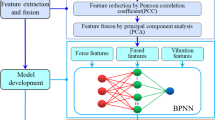Abstract
This paper is based on the investigation of the relationship between the processing parameters and the characteristic parameters of acoustic emission signal (AE signal) including RMS value, ringing count, and signal spectrum during the grinding of several difficult-to-machine metallic materials; the variation of AE signal characteristic parameters and spectrum with the parameters of grinding depth ap, grinding wheel velocity vs, and feed velocity vw was analyzed, then the corresponding relationship between acoustic emission signal characteristic parameters and machining surface roughness was given. On this basis, the multi-information fusion algorithm based on BP neural network was used to reasonably fuse various characteristic parameters of AE signals, then predict and recognize the surface roughness of grinding workpieces. Finally, the established model was optimized by using genetic algorithm, which significantly improved the prediction accuracy and provided a reliable prediction model for the grinding of difficult-to-machine alloys, providing a feasible method for predicting surface roughness for practical production.






















Similar content being viewed by others
Data availability
The datasets used or analyzed during the current study are available from the corresponding author on reasonable request.
Code availability
Not applicable.
References
Sun C, Xiu SC, Zhang P, Li QL, Zou XN, Ma L (2022) Influence of the dynamic disc grinding wheel displacement on surface generation. J Manuf Process 75:363–374
Li QL, Xiu SC, Sun C, Yao YL, Kong XN (2022) Analysis of the uniformity of material removal in double-sided grinding based on thermal–mechanical coupling. Int J Adv Manuf Technol 1–13
Hundt W, Leuenberger D, Rehsteiner F, Gygax P (1994) An approach to monitoring of the grinding process using acoustic emission (AE) technique. CIRP Ann Manuf Technol 43(1):295–298
Liu GJ, Gong YD, Wang WS (2001) Applications of acoustic emission technology in monitoring of grinding processes. Mech Eng 12:4–6
Sun Y, Jin LY, Gong YD, Wen XL, Yin GQ, Wen Q, Tang BJ (2022) Experimental evaluation of surface generation and force time-varying characteristics of curvilinear grooved micro end mills fabricated by EDM. J Manuf Process 73:799–814
Pan YH, Wang YH, Zhou P, Yan Y, Guo DM (2020) Activation functions selection for BP neural network model of ground surface roughness. J Intell Manuf 31(8)
Dornfeld D, Cai HG (1984) An investigation of grinding and wheel loading using acoustic emission. J Ind Eng Chem 106(1):28–33
Ding N, Zhao CL, Luo XC, Li QH, Shi YC (2017) An intelligent prediction of surface roughness on precision grinding. Solid State Phenom 261:221–225
Pandiyan V, Caesarendra W, Tjahjowidodo T, Tan HH (2018) In-process tool condition monitoring in compliant abrasive belt grinding process using support vector machine and genetic algorithm. J Manuf Process 31:199–213
Arun A, Rameshkumar K, Unnikrishnan D, Sumesh A (2018) Tool condition monitoring of cylindrical grinding process using acoustic emission sensor. Mater Today 5(5):11888–11899
Liu CW, Chen HC, Lin SC (2019) Acoustic emission monitoring system for hard polishing of sapphire wafer. Sens Mater 31(9):2681–2689
Hweju Z, Abou-El-Hossein K (2020) Surface roughness prediction based on acoustic emission signals in high-precision diamond turning of rapidly solidified optical aluminum grade (RSA443). Key Eng Mater 841:363–368
Liu H, Xu SH, Ge XM, Zahid MA (2019) Automatic sedimentary microfacies identification from logging curves based on deep process neural network. Cluster Comput 22(5)
Wang R, Jiang JC, Pan Y, Cao HY, Cui Y (2009) Prediction of impact sensitivity of nitro energetic compounds by neural network based on electrotopological-state indices. J Hazard Mater 166(1):155–186
Gao L, Li F, Huo PD, Li C, Xu J (2021) Accurate prediction of the extrusion forming bonding reliability for heterogeneous welded sheets based on GA-BP neural network. Int J Adv Manuf Technol (3)
Funding
This work is supported by the National Natural Science Foundation of China (No. 51771193, 52005092) and the Fundamental Research Funds for the Central Universities (No. N2103013).
Author information
Authors and Affiliations
Contributions
Guoqiang Yin: investigation, conceptualization, methodology, experiment, writing—original draft. Jiahui Wang: investigation, experiment, writing—reviewing and editing. Yunyun Guan: investigation, experiment. Dong Wang: funding. Yao Sun: funding, supervision.
Corresponding author
Ethics declarations
Ethics approval
The authors state that the present work is in compliance with the ethical standards.
Consent to participate
All the authors consent to participate this work.
Consent for publication
All authors agree to publish.
Competing interests
The authors declare no competing interests.
Additional information
Publisher's Note
Springer Nature remains neutral with regard to jurisdictional claims in published maps and institutional affiliations.
Rights and permissions
About this article
Cite this article
Yin, G., Wang, J., Guan, Y. et al. The prediction model and experimental research of grinding surface roughness based on AE signal. Int J Adv Manuf Technol 120, 6693–6705 (2022). https://doi.org/10.1007/s00170-022-09135-x
Received:
Accepted:
Published:
Issue Date:
DOI: https://doi.org/10.1007/s00170-022-09135-x




